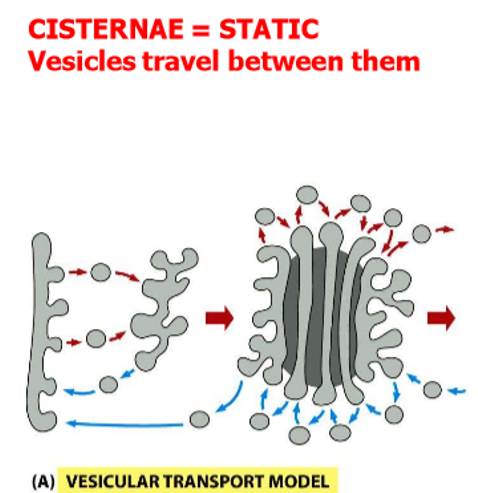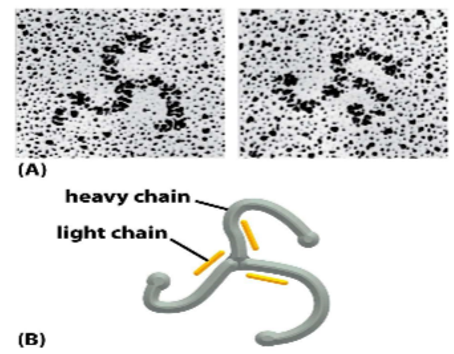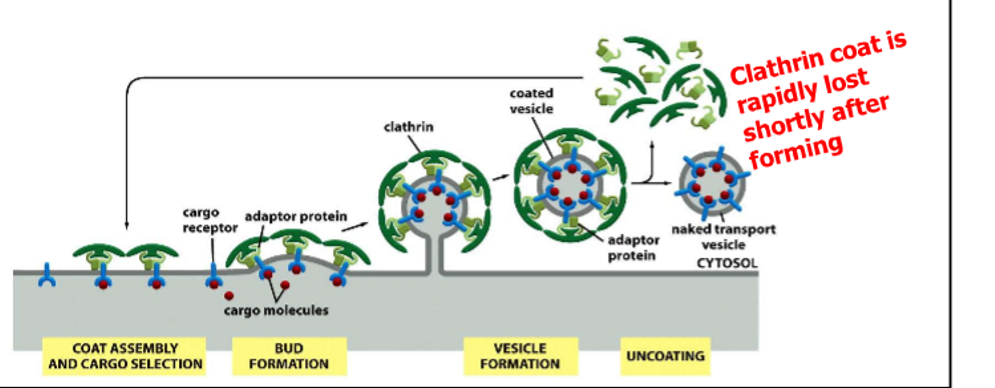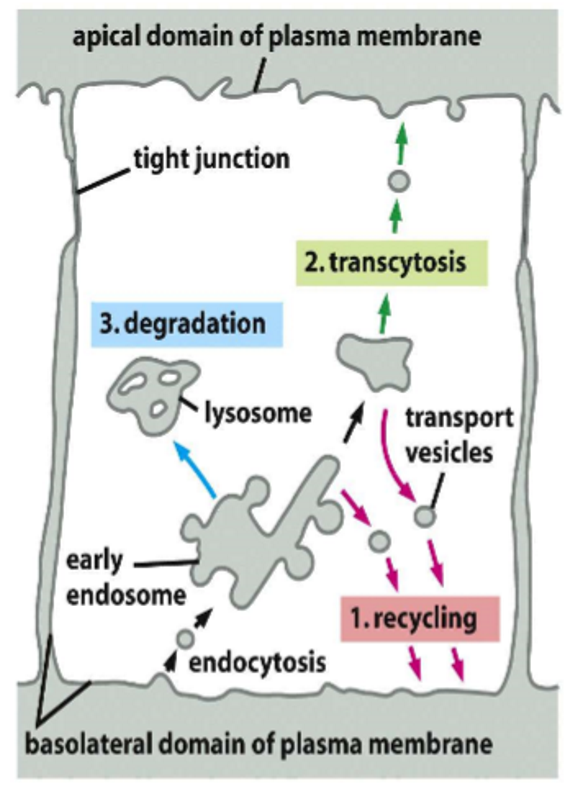vesicular transport
1/62
There's no tags or description
Looks like no tags are added yet.
Name | Mastery | Learn | Test | Matching | Spaced |
|---|
No study sessions yet.
63 Terms
protein transport between ER, golgi, plasma membrane and vesicles is achieved through
vesicular transport
how does vesicular transport work?
the vesicles travel between compartments in the cell along defined, regulated pathway and fuse specifically with their targetsto deliver their cargo.
3 protein coat complexes
clathrin, COPI, COPII
vesicular sorting depends on the assembly of a special — — formed at specific locations along a given donor compartment
protein coat
COPI
coats vesicles moving from golgi to ER, golgi to plasma membrane (secretory vesicles) and within the golgi
COPII
coats ER to golgi vesicles
clathrin
cell surface to the interior, traffics from golgi to endosomal compartments
the curvature of the membrane is based on the
the assembly of coat proteins
in order for fusion to happen, coat proteins must
disassemble
how do coat proteins recognze different membranes
via the membrane protein signals
info in the membrane themselves
phospholipids containing inositol head groups
mark organelles and membrane domains
inositol can get phosphorylated at various locations by different
lipid kinases— This phosphorylation can create distinct signaling molecules that play roles in cellular processes.
PI’s can recruit various proteins that possess
lipid binding domains
lipid binding domains
usually only recognize a specific type of PI (different types of phosphorylated positions)
how many different possible phosphorylated positions?
7
— — bind to membrane proteins and recruit coat proteins
adapter proteins
cargo receptors
bind to soluble proteins in organelles that recruit them into vesicles, in their cytoplasmic tails they recruit the adPTOR proteins which can then bind the coat proteins
what regulates vesicular transport
GTPases
GTPases control what processes in cell
Sar-1 (GTPase) function
regulates COPII assembly
Arf proteins (GTPases) function
regulates COPI and clathrin assembly
transport vesicles must be — — in recognizing the correct target membrane with which to fuse
highly selective
two classes of proteins involves in making sure vesicles trafficking and fusion of membrane occurs in highly selective manner
SNAREs and Rabs
target membranes display — receptors that recognize the appropriate markers
complementary
what type of protein is Rabs
GTPase, works together with other proteins to regulate the initial docking and tethering of the vesicle to the target membrane, they catch vesicles
SNARE proteins
catch vesicles (essentially spring loaded proteins) provide specificity, catalyze vesicular fusion with target membrane
v-SNAREs
on the vesicle
t-SNAREs
on the target membrane
both types of snares consist of
long alpha helices, form coiled coil — the force of this interaction drives the fusion of the membrane
To pull snares apart after fusion process finished
needs ATP
energy is needed to
pry apart v and t snares to their original states
Rabs (GTPase)
Tethering ng is — dependent, fusion is — dependent
GTP, ATP
any protein that has to go into a membrane enclosed organell that isnt nucleus, mitochondrion, chloroplast must pass through —
ER
membrane proteins have — — in their cytosolic tails that are recognized by coat proteins
exit signals
soluble proteins bind to cargo receptors that have exit signals in ther cytosolic tails
transport vesicles leaving the ER fuse together to form intermediate compartments called
vesicular tubular clusters
vesicular tubular clusters
travel towards golgi via motor proteins on microtubule tracks, generate coated vesicles going back to the ER (retrograde transport)
ER retrieval signals
membrane ER resident proteins, soluble Er resident proteins
membrane ER resident proteins
retrieval signals in their cytosolic tails, recognized by COPI coat proteins
soluble ER resident proteins
retrieval signals within their structure bind to receptors, ex. KDEL sequences
KDEL
brings things back to ER, interact with COPI proteins
two current models for how cargo travels through golgi
cisternae: static and dynamic
static cisternae — vesicular transport model
golgi doesn’t change
vesicles travel between them
vesicles can move forward and backward

dynamic cisternae — cisternal maturation model
move upward, changing their properties slightly as they migrate
as new membrane comes in it becomes the cis phase, the previous cis phase becomes a medial phase, and the trans phase gets pushed off
two pathways to transport from the trans golgi to the cell exterior
constitutive secretory pathway and regulated secretory pathway
constitutive secretory pathway
vesicles bud off from golgi, get to membrane recognized by RABS, snares snap in place, which fuses to the membrane and allows secretion
once in right place, it will fuse and secrete
regulated secretory pathway
only secreted on demand/when needed
they are concentrated in secretory vesicles but cannot be transported unless there is outside signal
Ca used for this most of the time
clathrin-coated vesicles
used for transport between plasma membrane, endosomal system, and golgi
1st coat protein
composed of 3 copies each of heavy chain and light chain
arranged in a “triskelion”

clathrin

the pinching off of clathrin coated vesicles is controlled in part by the cytoplasmic protein —
dynamin
dynamin
GTP and lipid binding
how to target materials to get to lysosomes
carry a unique marker: mannose 6 phosphate (M6P) groups which is added to N linked oligosaccharides in cis-golgi
this is then recognized by M6P reeptor in TGN and packaged into clathrin-coated vesicles for delivery to lysosomes
endosomes
intermediate organelles in vesicular transport pathways
vary in size/shape
receive cargo from golgi and PM
not permanent
three classes of endosomes
early, late, recycling
early endosomes
as a result of endocytosis
recycling endosomes
brings materials back up to plasma membrane
how do early endosomes mature
by becoming increasingly acidic and hydrolitic
multivesicular bodies
when late endosomes end up creating vesicles into itself
phagocytosis, what are the vesicles called?
cell eating, ingestion of large particles (ex. microorganisms/dead cells); phagosomes
pinocytosis — what are the vesicles called
cellular drinking, pinocytic vesicles; includes receptor mediated endocytosis
cholesterol gets into cells via
receptor mediated endocytosis
transcytosis
molecules internalized at one end of a ‘polarized’ cell are transported to a different end
